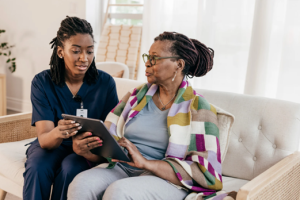Imagine you’re a patient
You’re a patient with an ultra-rare diagnosis, and there is a cutting-edge clinical trial available, but the nearest clinical trial treatment center is 5 states away. You and your family pack up and fly to the site to participate in the clinical trial. The clinical trial requires many follow up visits over a long period of time, several years. You and your family don’t have the money, time, physical or emotional strength to make the journey from your home state to your clinic as often as the clinical trial requires.
But imagine there’s an option to have a mobile nurse come to your home and perform clinical trial visits with you right in your own home.
You live in the same state as the patient, but you have to drive 2.5 hours one-way to get from your house to their house. When you arrive, you lug your large, heavy, awkward mobile centrifuge, supplies, kits, and equipment into the patient’s home and sit down at their dining room table to start the visit. First, you have to fill out the research paperwork which consists of 15 pages of questions about the patient’s adverse events, concomitant medications, and concomitant procedures. Next, you perform and record vital signs and measure the patient’s weight, height, and head circumference. Then, you draw 4 tubes of blood. One of the tubes has to be spun at 1 speed for 1 duration, another tube has to be spun at a different speed for a different duration, and yet another tube doesn’t need to be spun at all. One draw tube must be aliquoted into a very specific transfer tube while the other draw tube must be aliquoted into a different, but very specific transfer tube. If you transfer draw tube 1 into transfer tube 2 and draw tube 2 into transfer tube one, then all of your effort is for naught. After collecting and aliquoting all of the blood, you start collecting other specimens: you swab the patient’s mouth for a saliva sample, you collect and aliquot urine, and you collect and aliquot stool.
Now you have 15 tubes of biospecimens and 15 pages of paperwork in front of you. Some of the tubes must be shipped on dry ice to the lab destination, some of the tubes must be shipped ambient also to the lab destination, and the paperwork must be shipped in the envelope to the site which is a completely different destination than the lab. If the dry ice samples end up in the ambient box or vice versa, or if the paperwork accidentally goes to the lab and the samples to go the site, then again, all will be for naught.
What we do is not easy or inexpensive, but at the end of the day, all the complexities and all of the cost are completely worth it, because we’ve been part of a larger system that empowers patients to participate in trials that otherwise would never have been possible.



